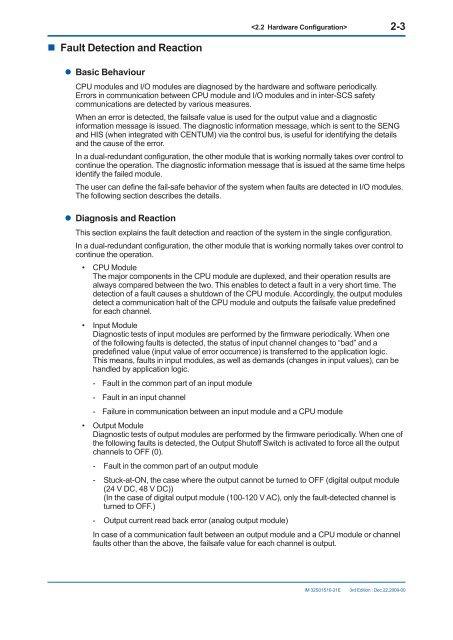Safety Manual - Tuv-fs.com
Safety Manual - Tuv-fs.com
Safety Manual - Tuv-fs.com
You also want an ePaper? Increase the reach of your titles
YUMPU automatically turns print PDFs into web optimized ePapers that Google loves.
2-3• Fault Detection and Reaction• Basic BehaviourCPU modules and I/O modules are diagnosed by the hardware and software periodically.Errors in <strong>com</strong>munication between CPU module and I/O modules and in inter-SCS safety<strong>com</strong>munications are detected by various measures.When an error is detected, the failsafe value is used for the output value and a diagnosticinformation message is issued. The diagnostic information message, which is sent to the SENGand HIS (when integrated with CENTUM) via the control bus, is useful for identifying the detailsand the cause of the error.In a dual-redundant configuration, the other module that is working normally takes over control tocontinue the operation. The diagnostic information message that is issued at the same time helpsidentify the failed module.The user can define the fail-safe behavior of the system when faults are detected in I/O modules.The following section describes the details.• Diagnosis and ReactionThis section explains the fault detection and reaction of the system in the single configuration.In a dual-redundant configuration, the other module that is working normally takes over control tocontinue the operation.• CPU ModuleThe major <strong>com</strong>ponents in the CPU module are duplexed, and their operation results arealways <strong>com</strong>pared between the two. This enables to detect a fault in a very short time. Thedetection of a fault causes a shutdown of the CPU module. Accordingly, the output modulesdetect a <strong>com</strong>munication halt of the CPU module and outputs the failsafe value predefinedfor each channel.• Input ModuleDiagnostic tests of input modules are performed by the firmware periodically. When oneof the following faults is detected, the status of input channel changes to “bad” and apredefined value (input value of error occurrence) is transferred to the application logic.This means, faults in input modules, as well as demands (changes in input values), can behandled by application logic.- Fault in the <strong>com</strong>mon part of an input module- Fault in an input channel- Failure in <strong>com</strong>munication between an input module and a CPU module• Output ModuleDiagnostic tests of output modules are performed by the firmware periodically. When one ofthe following faults is detected, the Output Shutoff Switch is activated to force all the outputchannels to OFF (0).- Fault in the <strong>com</strong>mon part of an output module- Stuck-at-ON, the case where the output cannot be turned to OFF (digital output module(24 V DC, 48 V DC))(In the case of digital output module (100-120 V AC), only the fault-detected channel isturned to OFF.)- Output current read back error (analog output module)In case of a <strong>com</strong>munication fault between an output module and a CPU module or channelfaults other than the above, the failsafe value for each channel is output.IM 32S01S10-21E3rd Edition : Dec.22,2009-00















